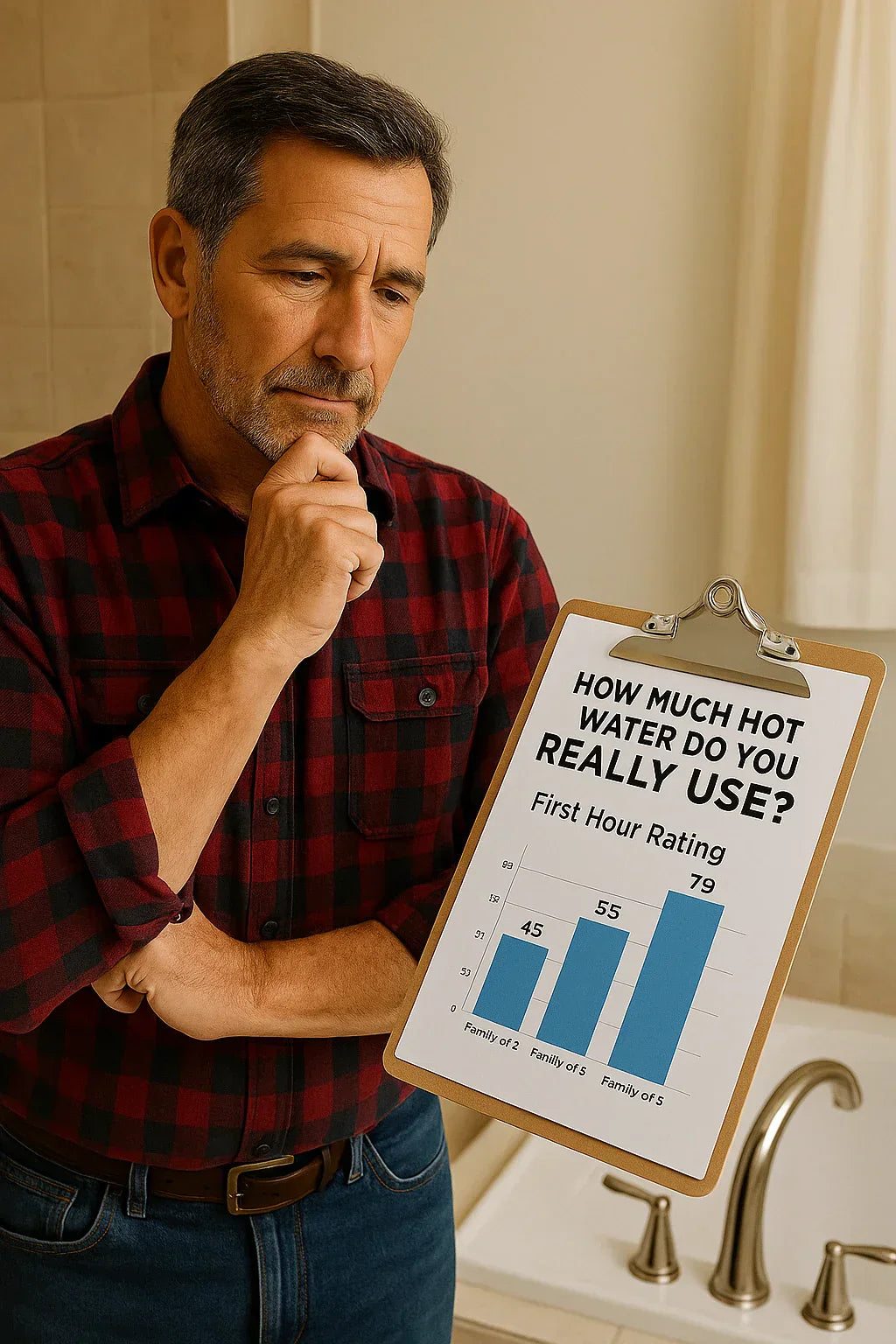If you’ve ever stepped into the shower only to be hit with cold water, you know the frustration of running out of hot water. But how do you know how much hot water your household actually uses? More importantly, how can you find a water heater that keeps up with your family’s needs?
That’s where First Hour Rating (FHR) comes in—a key performance spec that’s often overlooked but critical to choosing the right electric water heater.
This guide breaks down what FHR means, how it’s calculated, and how to match it to your household’s real-world hot water habits.
❓ What Is First Hour Rating?
First Hour Rating (FHR) is the number of gallons of hot water a fully heated tank can supply in the first hour of use.
It combines two things:
-
The tank capacity (e.g., 50 or 60 gallons)
-
The recovery rate (how fast it reheats water)
FHR is measured under controlled conditions and printed on the yellow EnergyGuide label.
Example:
-
A 50-gallon tank with a 20 GPH (gallons per hour) recovery rate could have an FHR of 70 gallons:
50 gallons (storage) + 20 gallons (recovery in 1 hr) = 70 gallons FHR
🧲 How to Estimate Your Household's Hot Water Demand
The best way to match your water heater to your needs is to figure out your home’s peak hour demand—usually morning or evening.
Common Appliance & Fixture Usage:
| Use | Gallons per Use |
|---|---|
| Shower | 10-15 gallons |
| Shaving | 1-2 gallons |
| Hand washing (per person) | 1-3 gallons |
| Dishwasher cycle | 6-10 gallons |
| Clothes washer (hot setting) | 7-15 gallons |
Add up your typical usage in one hour to find your target FHR.
🌟 Real-World Examples
Family of 4, Morning Rush
-
3 showers: 40 gallons
-
Dishwasher & laundry: 20 gallons
-
Handwashing & misc.: 10 gallons
-
Total FHR needed: ~70 gallons
Couple With Occasional Guests
-
2 short showers: 20 gallons
-
Dishwasher: 8 gallons
-
FHR needed: ~30-40 gallons
If your usage exceeds your water heater's FHR, you’ll likely run out of hot water during peak times.
Use AO Smith’s sizing tool to calculate your needs.
🔢 FHR vs. Tank Size: Not the Same Thing
Many people assume that tank size = capacity. But tank size doesn’t tell the full story.
| Tank Size | Recovery Rate | First Hour Rating |
| 50 gal | 20 GPH | ~70 gallons |
| 60 gal | 22 GPH | ~80-90 gallons |
Two 50-gallon tanks from different brands could have different FHRs due to element wattage, insulation, and design.
⚡ What Affects First Hour Rating?
1. Element Wattage
-
4500W vs. 5500W elements recover faster
2. Tank Insulation
-
Higher R-value reduces standby loss
3. Cold Water Inlet Temperature
-
Lower ground temps (winter) = slower recovery
4. Thermostat Settings
-
Most are set to 120°F—125°F by default
-
Higher settings increase usable capacity, but risk scalding
🔍 How to Find the FHR on a Water Heater
Look for the EnergyGuide label (yellow tag) on the unit. It will show:
-
FHR in gallons
-
Estimated yearly energy cost
You can also check manufacturer sites like:
🛠️ Improving FHR Without Changing Tank Size
Not ready to upsize to a 60-gallon unit? Try these:
1. Install Low-Flow Fixtures
-
Reduce shower usage from 15 to 7 gallons
2. Stagger Water Usage
-
Avoid simultaneous showers and laundry
3. Adjust Thermostat (carefully!)
-
Increasing from 120°F to 130°F increases usable water
-
Use a mixing valve to avoid scalding
4. Insulate Tank and Pipes
-
Keeps stored water hotter longer
🚧 When to Upgrade Based on FHR
You may want to upgrade your water heater if:
-
You’re consistently running out of hot water
-
You’ve added new appliances or family members
-
You’re finishing a basement or adding a second bathroom
A jump from a 50-gallon to a 60-gallon tank may add 15-25 gallons to your FHR—enough for another shower or two.
Check ENERGY STAR models for options with high FHR and rebate eligibility.
✅ Final Takeaway: Choose Based on Usage, Not Just Size
FHR gives you a realistic picture of how much hot water you can use in an hour—which matters way more than just tank capacity.
To avoid cold showers and grumpy mornings:
-
Calculate your peak demand
-
Check the FHR label
-
Size your water heater accordingly
Need help choosing? Use the Furnace Outlet Sizing Tool or talk to a licensed pro before buying your next water heater.
In the next topic we will know more about: How to Install a 50–60 Gallon Electric Water Heater: DIY or Call a Pro?







